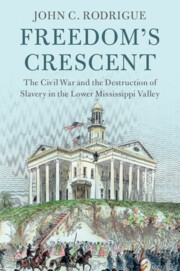Book contents
- Freedom’s Crescent
- Cambridge Studies on the American South
- Freedom’s Crescent
- Copyright page
- Dedication
- Epigraph
- Contents
- Figures
- Acknowledgments
- Abbreviations
- Additional material
- Introduction
- Prologue Life – and Labor – on the Mississippi
- Part I From War for Union to Military Emancipation, 1860–1862
- Part II From Military Emancipation to State Abolition, 1863
- 5 “The Return of the Seceded States to This Union as Slave States”
- 6 “Repugnant to the Spirit of the Age”
- 7 “The Greatest Question Ever Presented to Practical Statesmanship”
- 8 “The Name of ‘Slavery’”
- 9 “Repudiating the Emancipation Proclamation and Reestablishing Slavery”
- Part III Abolition: State and Federal, 1864
- Part IV The Destruction of Slavery, 1865
- Epilogue Memphis and New Orleans: May 1–3 and July 30, 1866
- Bibliography
- Index
9 - “Repudiating the Emancipation Proclamation and Reestablishing Slavery”
from Part II - From Military Emancipation to State Abolition, 1863
Published online by Cambridge University Press: 19 January 2023
- Freedom’s Crescent
- Cambridge Studies on the American South
- Freedom’s Crescent
- Copyright page
- Dedication
- Epigraph
- Contents
- Figures
- Acknowledgments
- Abbreviations
- Additional material
- Introduction
- Prologue Life – and Labor – on the Mississippi
- Part I From War for Union to Military Emancipation, 1860–1862
- Part II From Military Emancipation to State Abolition, 1863
- 5 “The Return of the Seceded States to This Union as Slave States”
- 6 “Repugnant to the Spirit of the Age”
- 7 “The Greatest Question Ever Presented to Practical Statesmanship”
- 8 “The Name of ‘Slavery’”
- 9 “Repudiating the Emancipation Proclamation and Reestablishing Slavery”
- Part III Abolition: State and Federal, 1864
- Part IV The Destruction of Slavery, 1865
- Epilogue Memphis and New Orleans: May 1–3 and July 30, 1866
- Bibliography
- Index
Summary
Following Federal capture of Little Rock, Arkansas Unionists prepare during fall 1863 for free-state convention, to meet in early 1864. Conservative Unionists in Tennessee petition Lincoln to recognize their gubernatorial election, but Federal capture of Chattanooga revives hopes to organize free-state government in Tennessee. Andrew Johnson supports abolition of slavery in Tennessee. Conservative Unionists in Louisiana hold congressional elections in November and send members-elect to Congress. Free-state movement stalls in Louisiana during the fall, and Lincoln places General Nathaniel Banks in charge of organizing free-state government, warning of efforts by proslavery Unionists to organize a loyal government. “Etheridge Plot” features failed attempt by northern Democrats, along with southern and border-state conservative Unionists, to seize control of organizing closely divided House of Representatives in December 1863. Thirteenth Amendment introduced into Congress. Lincoln announces plan for Reconstruction, the ten-percent plan, in December.
Keywords
- Type
- Chapter
- Information
- Freedom's CrescentThe Civil War and the Destruction of Slavery in the Lower Mississippi Valley, pp. 185 - 220Publisher: Cambridge University PressPrint publication year: 2023

